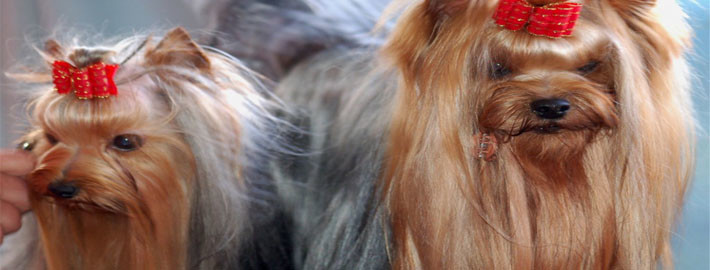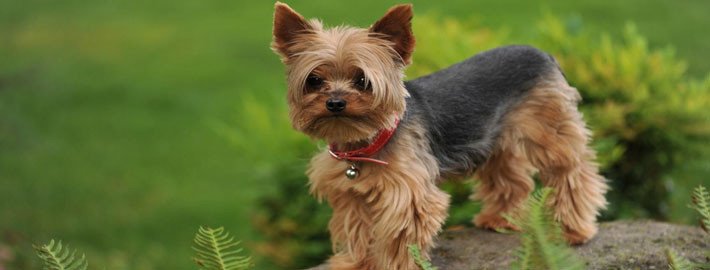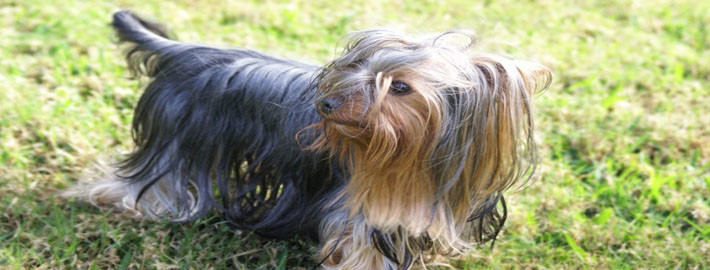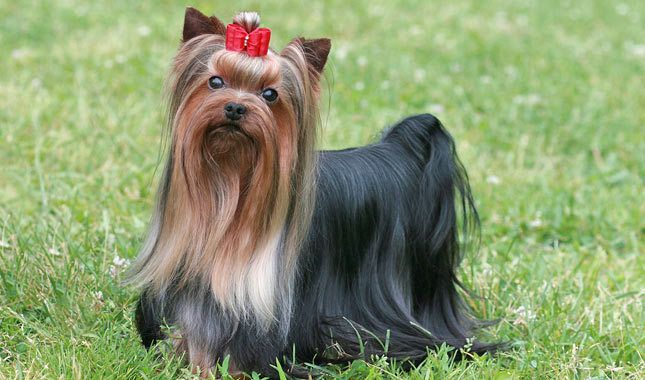What makes the Yorkshire Terrier Unique?
There is no denying that Yorkshire Terriers are quite adorable creatures, but these diminutive beauties do require some serious maintenance. Despite their small stature, members of this breed are anything but lapdogs and they will keep a household busy no matter what.
Breed Groups
Page Contents
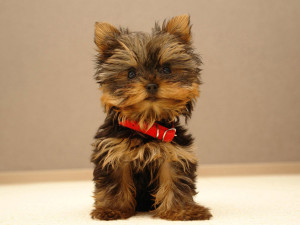
Is the Yorkshire Terrier Right For You?
These terriers have little notion of their true size and can quickly get into fights with other animals. It may become necessary for owners to keep a sharp eye on these tiny divas around large dogs and other non-canine pets, but most members of this breed are compatible with dogs that are about their own size. Yorkshire Terriers can be quite territorial and make excellent watchdogs as a result. Members of this breed are also known to bite if they are handled too roughly so they may not be the best choice of pet for households that contain small children.
In 5 Words
- Bright
- Active
- Frisky
- Athletic
- Loving
Characteristics
Learn About Yorkshire Terrier
Description
General Description
Yorkshire Terriers are formidable foes despite their dainty appearances. Members of this breed often have their long topknots tied up in ribbons or bows. Their straight, silky coats should be parted evenly so that it hangs down on either side of their bodies. These dogs also have tiny, well-proportioned bodies with level backs. They have small, flat heads and short muzzles. A level or scissors bite is acceptable for members of this breed. Yorkshire Terriers additionally possess straight forelegs and slightly bent hind legs. In countries where the practice is not illegal, these dogs will have their tails docked. Their dewclaws may also be removed.
Size
Yorkshire Terriers started out being much larger than they are today. Members of this breed typically weigh between 4 and 7 pounds (1.8 and 3 kilograms). According to American Kennel Club standards, Yorkshire Terriers should not exceed 7 pounds (3 kilograms) but there are some pets that nonetheless weigh more than 12 pounds (5.4 kilograms). Yorkshire Terriers typically stand between 8 and 9 inches (20 and 22 centimeters) in height.
Coat
These dogs have a lavish, silky coat that sweeps the ground if it is not kept clipped short. According to American Kennel Club breed standards, even show dogs are allowed to have the hair on their ears and feet trimmed so that they appear neat and tidy. Yorkshire puppies are black when they are born but their color develops over time. Members of this breed are typically bicolored. Blue or black colorations are usually found in combinations with either tan or gold.
Short History of the Yorkshire Terrier
Yorkshire Terriers came into existence in the 1800s when a number of breeds were crossed to produce a new type of dog that would be useful in killing rats and other vermin. Ancestors of the modern day Yorkie include Skye Terriers, the now extinct Clydesdale Terriers, and possibly Maltese dogs. Selective breeding was used to further reduce the dogs’ size. The breed was originally called Broken-haired Scottish Terriers when they were first shown in 1861. However, a large portion of their development took place in the county of Yorkshire and the dogs were eventually named after that location instead. The breed made their way to the United States around the 1870s but these dogs were not consistent in size. At the time, Yorkshire Terriers varied from about 3 pounds to close to 13 pounds but this characteristic has not changed in the decades that have passed since then.
Temperament
Yorkshire Terriers are generally confident, energetic, and extroverted. These friendly and inquisitive animals greatly enjoy meeting new people. They are also particularly devoted to their caretakers and will happily sleep with them at night. Members of this breed are particularly affectionate and enjoy playing games with members of their human families. However, they may not be inclined to let the humans win.
These terriers have little notion of their true size and can quickly get into fights with other animals. It may become necessary for owners to keep a sharp eye on these tiny divas around large dogs and other non-canine pets, but most members of this breed are compatible with dogs that are about their own size. Yorkshire Terriers can be quite territorial and make excellent watchdogs as a result. Members of this breed are also known to bite if they are handled too roughly so they may not be the best choice of pet for households that contain small children.
Caring for Your Yorkshire Terrier
General Health
Yorkshire Terriers are a typically healthy breed and they generally live between 12 and 16 years on average. Yet there are some health problems that have been known to arise from time to time. Owners should keep an eye out for bronchitis, herniated discs, spinal problems, and eye infections.
Many Yorkshire Terriers have tricky digestive systems so their owners should avoid giving them any unusual treats.Some members of this breed also have a low tolerance for anesthesia. Falls can often lead to serious injuries as Yorkshire Terriers have fragile bones that may break easily. Dogs that are particularly small may additionally suffer from abnormal skull formations.
Members of this breed are all prone to early tooth decay so keeping their teeth brushed is an important part of their care. Having their pearly whites cleaned regularly at the vet is another way to prevent problems from arising. Dry dog food and bones can also help with tooth cleanliness.
Care
Daily
These active little dogs will need to be walked at least once a day. However, they are playful and running around the house will often take care of most of their exercise needs.
Weekly
Yorkshire Terriers that have a clipped coat will need to be brushed several times per week. They should also have their teeth cleaned on a regular basis to prevent health problems from arising.
Monthly
Flea, tick, and heartworm prevention medication is typically administered once a month to protect pets from harmful parasites.
Grooming & Bathing
Yorkshire Terriers that are being shown require hours of professional grooming but most pet owners prefer to keep their dog’s fur clipped short. In either case, a dog will often have it’s hair tied up in a topknot with either a bow or ribbon. Their nails should be kept trimmed to prevent any injuries from arising. Members of this breed do not typically shed much so owners will not have to worry too much about having their households covered in fur.
Exercise & Training
Housetraining can be problematic for members of this breed. As is the case with most terriers, these dogs require firm and consistent training from their earliest days. They benefit greatly from positive reinforcement and rewards based training. Yorkshire Terriers will also need to receive appropriate amounts on exercise to keep them from becoming badly behaved or destructive. Members of this breed delight in having a regular playtime in a fenced area. Due to their high prey drive, Yorkshire Terriers should be kept on a leash when they are outdoors if they are not in a safely enclosed spot.

